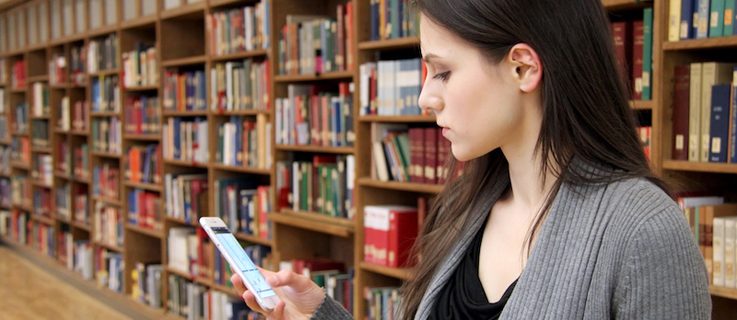Indoor Navigation in Libraries
Using a Smartphone to Get to the Reading Room

Navigation systems for enclosed spaces are becoming increasingly common. Visitors to libraries and museums can use them to find their way round and to access location-based information.
In their capacity as storehouses of knowledge and temples of learning, large libraries are often housed in impressive and imposing buildings. Inside we are often confronted with a wide range of learning environments and service areas: reading rooms, exhibition rooms, service counters for information and registration, and, of course, the lending desk. As these are often connected by a maze of long corridors that all look the same, with all kinds of stairs and floors in between, it is not always easy for new users and visiting tourists to find their way round.
These days, however, we have what is called "indoor navigation" and this enables you to know where you are in the building at any given time and to get to the place you are looking for in the quickest and most direct way. In the meantime, thanks to radio-based technologies, once a smartphone is inside the building, it is able to calculate its own position by using its special sensors to measure the strength of surrounding signals. These signals can, for example, be emitted from WiFi networks or special, matchbox-sized transmitters, so-called beacons (location transmitters).
Digital beacons
All the big technology companies have already started marketing their own systems: in 2013 Apple launched its Standard iBeacons, a year later Samsung introduced its Proximity service and in July 2015 Google put its Beacon service<em> Eddystone</em> on the market. The localization technology, awiloc, developed by the Fraunhofer Institute for Integrated Circuits in Erlangen in Bavaria, operates, on the other hand, with the help of private routers, public Wi-Fi hotspots or corporate networks. When a smartphone uses these services, it has to have its own wireless LAN function switched on, as is also the case with the Indoor Google Maps service.These positioning and navigation systems are normally linked to an app. Maps that were created beforehand also have to be stored, so that the signal readings can be assigned to the corresponding locations. The signal readings are synchronized with the maps and the location can then be displayed in the app. In best case scenarios the location can be calculated within an accuracy margin of one to two meters.
It is not just the retail trade in Germany that is backing beacon technology, but German libraries are also going for it. For the retail trade it is not just the actual navigation feature and the collection of customer data that makes the technology attractive, this technology also enables the retail trade to launch location-based marketing campaigns, by drawing the public’s attention, for example, to discounts or new sales products at an appropriate time and place. For the libraries, however, the beacons offer a great opportunity. The visitors’ and users’ smartphones can guide their owners accurately around the building and provide additional information in the right places.
Opportunities for libraries
Up to now there is only one library in Germany that has adopted this approach and that is the Bavarian State Library in Munich. In the spring of 2016 it launched its app “BSB Navigator”. The Bavarian State Library installed a total of 250 beacons for the project. The map available on the App contains over 70 important destinations in the library building, along with related information. The visitor or user selects the desired destination using the search function or he selects one from a list of places of interest and the app shows him the most direct route.Other components of the “BSB Navigator” are two guided tours. The tours, “General Tour" and "Tourist Tour", take library visitors along a fixed route through the library, passing by, and maybe stopping at, important and interesting places. When the so-called “Discovery” mode is enabled, visitors receive information in the form of a text message on their smartphone as soon as they enter the vicinity of an interesting object or location.
The Bavarian State Library, as a public institution, has made sure that all the features of the “BSB Navigator” are fully in line with data protection laws. The app works completely offline and, unlike the retail trade, does not commercially divulge any data on user activities.
Navigations apps for museums
In the case of the Fraunhofer Institute’s awiloc localisation system, the disclosure of user data is not on the agenda at all. This is perhaps also one of the reasons why a number of German museums have decided to integrate this technology into their so-called museum guide systems. Since 2010 the Museum of Industrial Culture in Nuremberg has been equipping its visitors with iPod touch devices that are able to accurately recognize their own position and then provide background information on the exhibits – a total of 180 films, audio and text contributions.The State Museum of Egyptian Art in Munich in turn provides not only exhibit-related information, but also eight guided tours of the museums exhibitions. Other German museums with such multimedia guides are the world's largest computer museum - the Heinz Nixdorf Museum Forum in Paderborn - and the House of the History of Baden-Württemberg in Stuttgart. Unlike the “BSB Navigator”, these museums only provide their navigation apps on a rental basis. Due to licensing reasons the apps cannot be made freely available.
Irrespective of whether indoor navigation apps are beacon-based or WiFi-based, they are a valuable additional service in the portfolio of libraries and museums. The use of such apps might also be a worthwhile option for larger institutions, especially if they have extensive user and visitor areas that are possibly spread out over a number of buildings and sites.